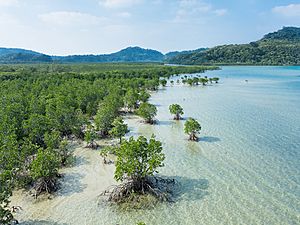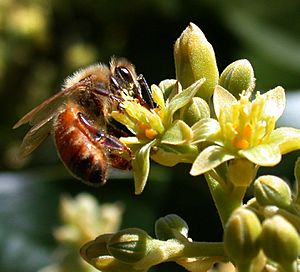Natural capital facts for kids
Natural capital is a way to describe the Earth's natural resources. This includes things like minerals, plants, and animals. We think of them as "capital" because they provide many important things for us. For example, they give us oxygen to breathe, clean our water, and stop the land from washing away. These helpful things are called ecosystem services.
In the past, people who studied economics saw "land" (nature) as different from "capital." Capital was usually seen as things made by humans, like factories. But nature gives us so many benefits!
A scientist named Robert Costanza looked closely at 17 of these benefits. He showed that nature's benefits are like the benefits from human-made capital. For example, a factory makes cars, and an apple tree makes apples. Both produce valuable things.
This idea helps us understand the value of nature. It's different from just seeing nature as a passive natural resource. However, we are still learning about the natural world. So, we don't yet know everything that "natural capital" truly means.
Contents
What is Natural Capital?
Natural capital refers to all the natural assets on Earth. These assets include things like clean air, fresh water, forests, oceans, and fertile soil. They are called "capital" because they provide a continuous flow of valuable services and goods. These services are essential for human life and our economies.
Why is it important?
Thinking about nature as "capital" helps us understand its true value. It shows that damaging nature can have a big economic cost. For example, if a forest is cut down, we lose clean air, water filtration, and a home for animals. These are all valuable services that the forest provided for free.
Examples of Natural Capital
There are many examples of natural capital all around us:
- Forests: They produce oxygen, absorb carbon dioxide, prevent soil erosion, and provide wood and homes for wildlife.
- Rivers and Lakes: They provide fresh drinking water, support fish, and can be used for transport or energy.
- Oceans: They regulate the climate, provide food (fish), and are home to countless species.
- Soil: Healthy soil is needed to grow food and supports plant life.
- Pollinators: Insects like bees help plants grow fruits and vegetables.
Ecosystem Services
The benefits we get from natural capital are called ecosystem services. These are the processes by which natural environments produce resources that are necessary for our survival.
Types of Ecosystem Services
There are four main types of ecosystem services:
- Provisioning Services: These are the products we get from ecosystems.
- Examples: Food (crops, fish), fresh water, timber, natural medicines.
- Regulating Services: These are the benefits from the regulation of ecosystem processes.
- Examples: Climate regulation (forests absorbing carbon), flood control (wetlands absorbing water), disease control, water purification.
- Cultural Services: These are the non-material benefits people gain from ecosystems.
- Examples: Recreation (hiking, fishing), spiritual enrichment, aesthetic beauty, educational opportunities.
- Supporting Services: These are the services necessary for the production of all other ecosystem services.
- Examples: Nutrient cycling (like the phosphorus cycle), soil formation, primary production (plants making their own food).
Protecting Natural Capital
It's very important to protect our natural capital. When we damage nature, we lose these valuable services. This can lead to problems like water shortages, air pollution, and less food.
Many people are now working to manage natural capital wisely. This means using resources in a way that doesn't harm them for future generations. It's about understanding that our economy and well-being depend on a healthy planet.
See also
 In Spanish: Capital natural para niños
In Spanish: Capital natural para niños
Images for kids
-
The many parts of natural capital provide important goods and ecosystem services. These support our main global needs, like food, water, fighting climate change, and energy.






